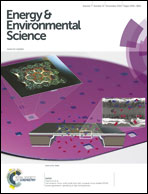A three-dimensional hexagonal fluorine-doped tin oxide nanocone array: a superior light harvesting electrode for high performance photoelectrochemical water splitting†
Abstract
Photonic nanostructures hold great promise in promoting light harvesting. Here we report the first design and construction of a three-dimensional (3D) hexagonal nanocone array of fluorine-doped tin oxide (FTO) on glass as an excellent electrode for photoelectrochemical (PEC) water splitting. The PEC current density with suitably deposited Ti-doped hematite at 1.23 V vs. the reversible hydrogen electrode (RHE) was increased by 86% to 2.24 ± 0.02 mA cm−2 compared to that with the planar counterpart, mainly ascribable to the special light harvesting effect and the electrode surface area provided by 3D FTO. Upon the embedment of a gold layer to concentrate the incident light onto the hematite layer and the deposition of the Co–Pi catalyst with a modified procedure, the photocurrent experienced a large cathodic shift of onset potential by 360 mV and soared to a high value of 3.39 ± 0.01 mA cm−2 (at 1.23 V), yielding a power conversion efficiency of 0.70% at a potential as low as 0.88 V vs. RHE.


 Please wait while we load your content...
Please wait while we load your content...